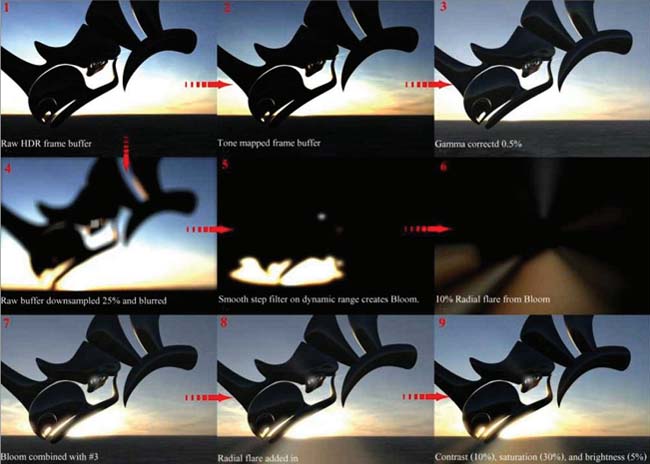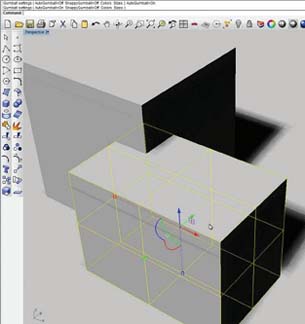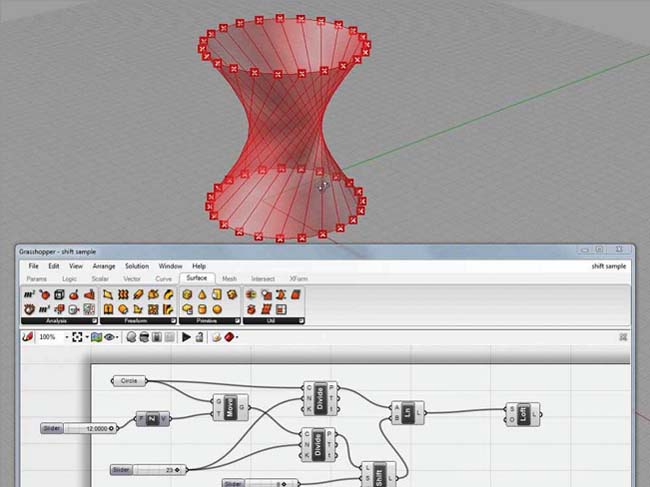Latest News
July 1, 2010
By Mike Hudspeth
In the world of 3D modeling there are plenty of ways to get your job done. There’s the wireframe modeler (which concerns itself with a curve’s two end points and all the points in between), surface modelers (which also keep track of all the points enclosed between curves and are really good at describing complex shapes), and at the top of the heap, solid modelers (which know the inside of the model from the outside). The really great 3D modeling programs do all three: wireframe, surfaces, and solids. One such modeler is Rhinoceros 5 from McNeel North America (formerly Robert McNeel and Associates).
 Figure 1: By varying the renderer you use you can produce subtle differences that can make or break an image. |
Rhino, introduced about 12 years ago, has made great inroads into the industrial design community as a result of both its great modeling ability and its low price—not to mention its terrific translating ability. Continuing a long-standing policy, Rhino 5 is available for free to anyone with version 4 until the next release. Probably the biggest feature of the Rhino 5 release is its availability for Mac in a flavor called Rhino OS X.
And I’m told Rhino OS X (for OSX 10.5 and later) works in a very Mac-like manner. And Windows plug-ins for Rhino will not work in Rhino OS X. You can also get Rhino 5 in either 32-bit or 64-bit versions. Remember that 32-bit machines (the vast majority of all PCs) can’t address RAM in quantities of more than 2GB. That means huge files won’t just be slow, they won’t even load if they are bigger than 2GB. 64 bit machines aren’t as limited. They can address as much memory as you can load. (If your files are never that big you probably don’t have much to worry about. But if you are shopping for a new computer don’t let that dissuade you from looking at 64-bit machines. Even if you don’t work on huge files, having that additional bandwidth will make things flow smoother through your machine.)
 Figure 2: By clicking and dragging on the gumball you can move and rotate your model in all sorts of ways. |
Visualization
Real-time rendering and shading gives you live materials and textures. This means you’ll be able to apply the material and textures you will have on the actual design and be able to rotate and model with it. Who wouldn’t like that? Imagine how much easier it will be if you are working on a design that includes many different materials. You’ll be able to see at a glance if a part is brass or steel, cast or machined. It’ll save time and make your models more realistic. At the moment there’s a lot of interest in different renderers. They don’t all work the same and will give you different results (see Figure 1). Rhino 5 lets you kick the tires of several. That way you can see what each can do and determine why you might want to use one over another and when. And Rhino 5 will include more sophisticated materials. That means they will act more realistically.
Rhino 5 has some good new things in its interface. In Rhino 5 you will have better control of your lights. There are new capabilities (like edge softness) that will make you look like a wizard. Rhino 5 has tabbed toolbars (I’m still not altogether sure how this is so different from drop down menus, but what do I know?) so you have access to tons of commands without having to take up precious screen real estate. The Gumball (drag handles on steroids) controls orientation of whatever you have selected, not the view (see Figure 2). If you drag the blue and red icon, your selection moves along the plane the icon depicts. And Rhino 5 is even faster than previous versions.
Command And Conquer
A great new command for Rhino 5 is the Shell Poly Surface—a shell (or hollow) command. No longer will you have to build the inside of your model—a tedious and often difficult task that always leaves you open to errors. Rhino 5 uses HDRI backgrounds (which have built-in lighting values). That means the lighting in the background image sets the lighting for your model. If you design beach furniture you can put it on screen with a beach scene in the background and the lighting on your model will be the same. It’ll be almost like you were actually there—or at least look like your product was.
Rhino has always been famous for its ability to read in and out just about any file format. I know people who have never modeled with it, but bought it just for its translating power. It will open just about anything. You can even take solids in or out in DWG format. And speaking of compatibility, a fun, yet useful capability in Rhino 5 is that you can view your Rhino files on your iPhone or iPad, which can help immeasurably on the road at a vendor site.
Do you like to build models with plastic and glue? Building concept models is one of the fun sides of the business, but don’t have to be plastic. You can make them out of card stock and Rhino 5 can help you with this. Surface unrolling can be very handy for form and fit models. Just model your design in Rhino 5 and then unroll the faces into a flat pattern.
 Figure 3: Rhino’s add-on Grasshopper is a graphic modeler that lets you control your model by visual means. |
Good Stuff & Passion
Rhino 5 isn’t just a great modeling tool, it’s also a development platform. Companies are making their own add-ons. Even you can “Roll your own” add-ons. The Rhino people have introduced new software that increases your capability. Rhino Python is a new cross-platform scripting language for building add-ons. It’s easier to learn than others (like C or Visual Basic). Python is expandable so it grows as your sophistication grows. Grasshopper is a visual programming language (see Figure 3). It’s like a drag-and-drop interface editor but with 3D models. Used on shapes that are too sophisticated for standard software (like those driven by databases). You can use it to drive your models by cross-section shapes.
Good design is all about passion. Either you have the passion or you wish to instill passion for your designs in your clients. Rhino 5 is a great tool for designing what you are passionate about. It’s not overly expensive at $995, it’s pretty easy to learn, and comes with all the right tools. Open the floodgates of possibilities.
More Info:
McNeel North America
Mike Hudspeth, IDSA, is an industrial designer, illustrator, and author who has been using a wide range of CAD and design products for more than 20 years. He is DE’s expert in ID, design, rapid prototyping, and surfacing and solid modeling. Send him an e-mail about this article to [email protected].
Subscribe to our FREE magazine, FREE email newsletters or both!
Latest News






